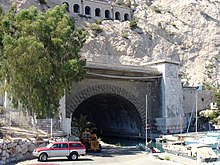Canal du Rove

The southern portal
|
|
| Overview | |
|---|---|
| Location | Marseille area |
| Coordinates | South portal: 43°21′35″N 5°17′38″E / 43.359642°N 5.293919°E North portal 43°23′59″N 5°13′29″E / 43.399599°N 5.224739°E |
| Status | Closed |
| Start | L'Estaque (south) |
| End | Étang de Berre (north) |
| Operation | |
| Opened | 1927 |
| Character | Canal tunnel |
| Technical | |
| Length | 7,120 metres (23,360 ft) long |
| Tunnel clearance | 15 m (49 ft) |
| Width | 22 m (72 ft) |
The Rove Tunnel is a canal tunnel in France that connected Marseille to the Rhône river. It was opened in 1927 and closed in 1963. With a length of 7,120 metres (23,360 ft) it was a major work of civil engineering and one of the longest such tunnels.
The tunnel was the most challenging section of the Canal de Marseille au Rhône, which connected Marseille to the Rhône river. The canal has a total length of 81 kilometres (50 mi). The tunnel starts near the village of Le Rove, and runs through the Chaîne de l'Estaque at sea level. The tunnel is 7,120 m (23,360 ft) long, 22 m (72 ft) wide and 11.4 m (37 ft) high. The water depth is 4 m (13 ft). It remains the biggest canal tunnel in the world, as far as shipping canals are concerned. As a part of the Canal de Marseille au Rhône, it used to connect the Étang de Berre in the north with L'Estaque in the south, both hosting a part of Marseille's harbour.
The possibility of building a canal tunnel had been discussed for many years. A proposal was developed for the Marseille Chamber of Commerce in 1879 by the engineer Guérard, but no action was taken until an act of 24 December 1903 authorized the project. The initial plan was for an 18 metres (59 ft) wide tunnel, which would only allow one-way traffic at any time, but this was later increased to 22 metres (72 ft) for two-way traffic despite the increase in cost. Preparatory work began in 1906.
Underground work began in 1910, using compressed air hammers to break through the rock. The contractor simultaneously worked from the south and from the north, and on a ventilation tunnel. Geological studies had not indicated any aquifer, but in fact the work was seriously affected by various irruptions of water. Work accelerated after the declaration of World War I on 1 August 1914. The laborers included Spanish and Portuguese, who replaced Italians recalled to their country at the outbreak of war, and prisoners of war.
On 19 February 1916 the central plug separating the north and south sections at 4,710 metres (15,450 ft) from the south portal was destroyed by dynamite. On 7 May 1916 Marcel Sembat, Minister of Public Works, and Joseph Thierry, Under-secretary of State for War, inaugurated the Rove Tunnel and the first two cranes of Port-de-Bouc. After many delays, the full canal was finally opened to traffic in April 1927. It was closed in 1963 after a section of the tunnel collapsed.
...
Wikipedia
